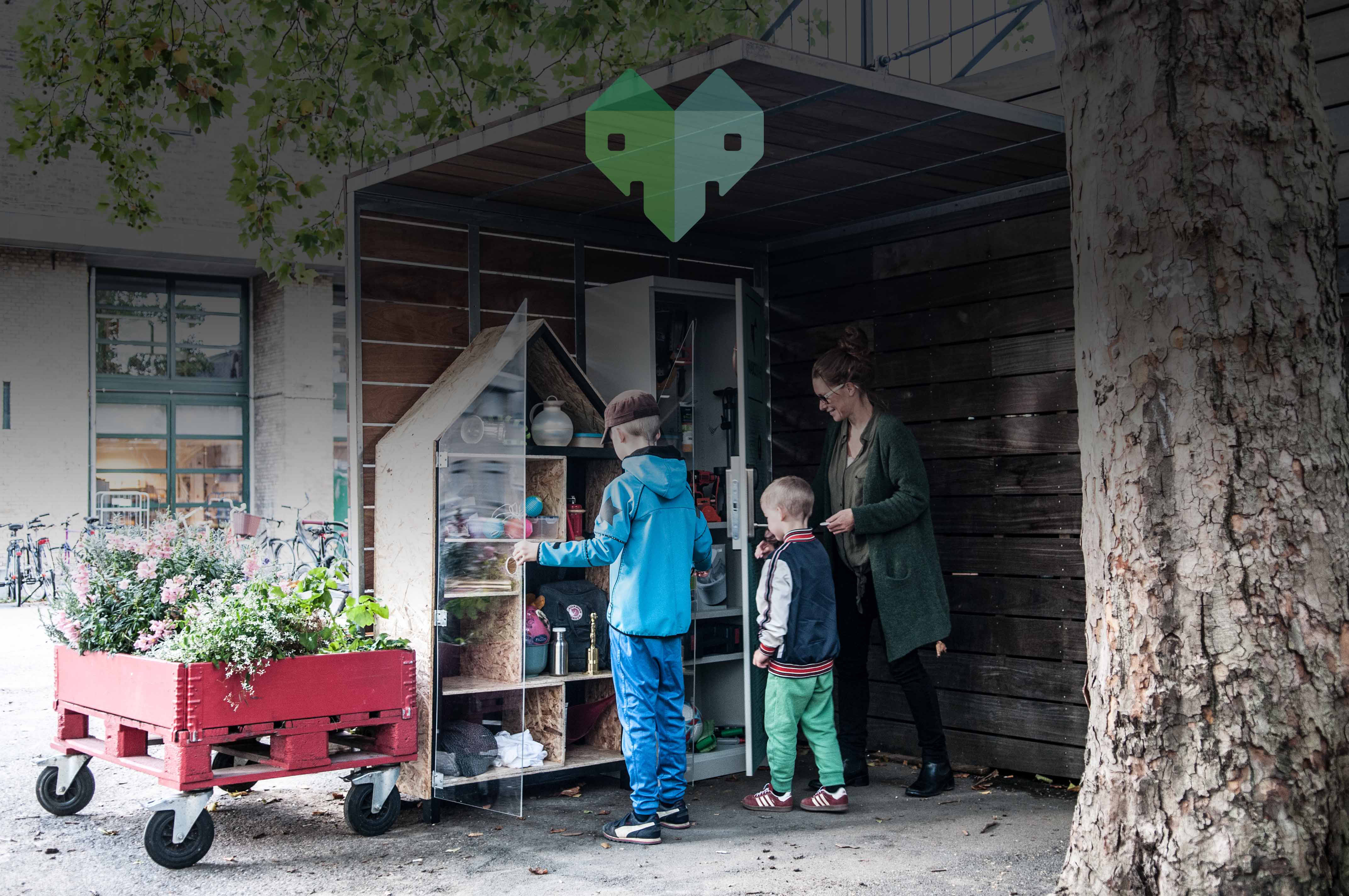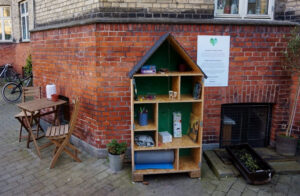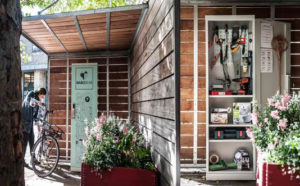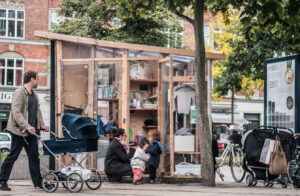
Local residents use Naboskab’s community closets to drop off unwanted items and pick up new items to use. (Image: Naboskab)
At Denmark’s Naboskab organization, it’s all about creating community closets that act as a social meeting place, and let neighbors share, and save space and money.
What is Naboskab?
“Naboskab” means neighborliness in Danish. It is composed of two words: The word for neighbor and the word for closet. It is also the name of one of the products that Naboskab provides. And it is the name of our not for profit organization. We’re all about sustainability, circular economy, recycling and sharing at the local level, via community closets. Kristoffer Ravnbøl, who has a masters degree in anthropology, founded the organization in 2014 along with Hanne Hjort Jensen, who has a masters degree in political science.
Naboskab offers consulting, user surveys, idea development, workshops and lectures in community, circular economy, recycling and sharing economy. We also provide some physical products/platforms based on the idea of community closets, including Bytteskab, Naboskab, and Byttestation (see below). We currently have more than 30 of these products spread across Eastern Denmark.
Naboskab’s Motto: “Let us share the future.” It refers to our belief in a future where we don’t just throw stuff away, but instead give someone else a chance to reuse our items. We believe that people do not need to own everything themselves and that sharing is the future — and community closets can play a big role.
Naboskab’s Vision: To develop new, creative, and innovative practices that change the way resources are used and viewed. We want to help individuals and societies believe that both sharing and recycling, via community closets will create a better and more sustainable future for everyone.
Naboskab’s Three Platforms for Sharing in Our Neighborhoods via Community Closets

Bytteskab community closet (Image: Isabella Sokoler)
1. Bytteskab is a community sharing closet/box for giving away and recycling stuff that someone no longer wants or needs. The items dropped off are perfectly reusable and are either taking up too much space or no longer useful to the original owner. By putting it in the Bytteskab, stuff has the potential to enjoy a new life in the home of your neighbors. This platform is mainly used in housing associations and small communities.

Naboskab Community Locker (Image: Christian Askær)
2. Naboskab is a community locker used for sharing a variety of things such as tools, kitchenware, gardening equipment, toys, electronics; the content is decided by the users. With the Naboskab, there is no need for you to own everything yourself — you simply need an app on your phone or a little electronic key tag to gain access and share with the people around you. This platform is mainly used in housing associations and small communities.

Byttestation, urban community closet. (Image: Chrisitan Askjær)
3. A Byttestation, much like the Bytteskab, is a community sharing closet / box for giving away and recycling stuff someone doesn’t want anymore. This platform, however, is placed around the city for public use.
Why Share via Community Closets?
Many people think that sharing and recycling are only about money and the environment. But recycling and sharing are about so much more! A sharing platform like a community closet can create a greater sense of neighborliness, act as a social meeting place, prevent loneliness, and save us all a great deal of space. If saving money and helping the environment are not good enough motivators to share, then these reasons might be.
Naboskab’s Community Closet Sharing Projects
Byttestation at Vesterbro in Copenhagen. A Byttestation community closet was made out of recycled materials and placed in the neighborhood of Vesterbro in Copenhagen. The platform is used by approximately 200 people a day, with more than 5 tons of stuff swapped every month. It is used by everyone from the homeless to families to the elderly.
Test of Bytteskabe Community Closet in Copenhagen and Frederiksberg Municipality by approximately 3500 people.
Network mapping: Mapping of 236 subjects in relation to a recycling project at a recycling center for the Administration of Technology and Environment.
 Test of Naboskab design for a Community Closet in the Municipality of Copenhagen using user surveys and interviews.
Test of Naboskab design for a Community Closet in the Municipality of Copenhagen using user surveys and interviews.
Maritime Trash Prevention: Investigation into how to prevent maritime trash produced by anglers, sailors, and bathers conducted for the Environmental Protection Agency.
Learn More about Naboskab and Its Community Closets
Go to www.naboskab.dk Our website is, at the moment, unfortunately only in Danish. You can also email us at info@naboskab.dk
Posting Guidelines – This and other stories published on WeHateToWaste.com are intended to prompt positive conversations about practical solutions for preventing waste. Opinions expressed are solely those of the contributors, and WeHateToWaste implies no endorsement of the products or organizations mentioned.

I wonder how these solutions–the three platforms for community sharing–could be implemented in New York City, which is densely populated and places a large emphasis on neighborhood pride.
I currently live in a building in Brooklyn which would benefit from an on-site “naboskab” of sorts. I think this would be an excellent way to help residents reduce personal consumption, save money & give them more free space in already small apartments! Plus, the digital element of the “naboskab” makes it super user-friendly.
This is a really great idea! It would especially be useful for kid’s clothes and shoes. Kids grow so fast it seems like a waste when they can’t fit into practically new clothes anymore. In response to Olivia S, another article on this site mentioned having a free box in your apartment building, that would be a good way for someone to implement this concept in their own life. I can also imagine having a set up in a library or some other public space where people could freely exchange stuff! This is a great concept to adopt in the US!
As a college student, the idea of Community Closets strikes me as a formalized version of the kind of sharing that goes own within college dorms. Interacting with neighbors through sharing helps to foster community on the small scale of college dorms; like Olivia S, I would be interested to see how Community Closets would function in a larger, city area. In addition, I have found that the largest conflicts involving sharing in college dorm arise when there is ambiguity about the sharing arrangement, whether it involves what is being shared, by how long, or among whom. To this end, I think that having three categories of Community Closets for distinct types of sharing is a great idea!
I could not agree more Abby. As a fellow college student, I think the implementation of a structured sharing program on campus would benefit both students and the environment in a number of ways. With the advent of online retail, students at my college are quick to order their own personal items such as vacuum cleaners or coffee machines, when in reality those items could easily be part of a dorm-wide sharing program. The majority of college students have limited funds so this would not only save them money but would eliminate the harmful environmental impact e-commerce is having on our planet. I will be studying abroad next fall in Copenhagen and will make sure to check out Naboskab’s Community Closet Sharing projects to see if their model might be something my college would want to implement.
Interesting read! I am studying abroad in Denmark next semester and am very curious now about whether or not I will encounter evidence of naboskab. Unlike several of the other comments on this post, I doubt the efficacy of this solution in the United States. Denmark operates on a culture that is much more collectivist than the individualistic capitalist culture of the United States, and I am unsure if these community closets would fulfill their desired function in certain areas of the country. I still think it is a great idea and deserves consideration for the United States, but the Danish design cannot just be copied in the US. What do other people think about this?
This is such a productive use of space! For the many others wondering how a system like this could be implemented into NYC, I would love to see more clothing donation and recycling companies like Goodwill and Restoration Hardware invest in these solutions for unwanted clothing. It feels like a better shopping experience than fanning through endless, overstocked racks. I am also curious to see if the app is able to track the clothing, for instance if someone takes a jacket then logs where that jacket is, and where it ends up. That would be a really interesting way to test the concept of Wardrobe Metabolism.